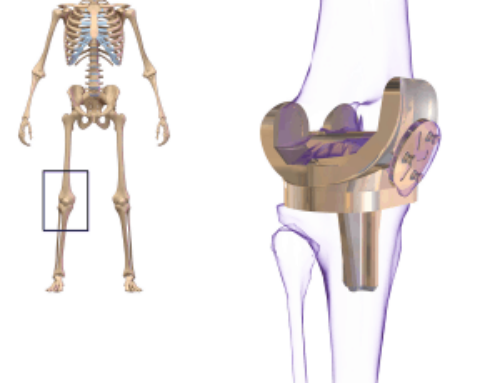A new study shows that walking reduces risk of functional limitation associated with knee osteoarthritis (OA). In fact, the study funded in part by grants from the National Institutes of Health (NIH) and published in the American College of Rheumatology (ACR) journal, Arthritis Care & Research, suggests that walking 6,000 or more steps per day may protect those with or at risk of knee of OA from developing mobility issues, such as difficulty getting up from a chair and climbing stairs.
Nearly 27 million Americans age 25 and older are diagnosed with OA according to a prevalence study by Lawrence et al. (Arthritis Rheum, 2008). Previous research reports that knee OA is the leading cause of functional limitation among older adults, making walking and climbing stairs difficult. Moreover, data from the National Health and Nutrition Examination Survey (NHANES III) state that 80% of OA patients have some limitation in movement, with 11% of adults with knee OA needing assistance with personal care assistance.
While walking is a common daily physical activity for older adults, medical evidence reports that two-thirds of U.S. adults with arthritis walk less than 90 minutes each week. “Our study examines if more walking equates with better functioning, and if so, how much daily walking is needed to minimize risk of developing problems with mobility in people with knee OA,” said Daniel White, PT, ScD, from Sargent College at Boston University in Massachusetts.
For the present study, researchers measured daily steps taken by 1788 people with or at risk for knee OA, who were part of the Multicenter Osteoarthritis Study. Walking was measured with a monitor over seven days and functional limitation evaluated two years later, defined as a slow walking speed and a Western Ontario and McMaster Universities Arthritis Index (WOMAC) physical function score greater than 28 out of 68.
Walking an additional 1,000 steps each was associated with between a 16% to 18% reduction in incident functional limitation two years later. Walking less than 6,000 steps daily was the best threshold for identifying those who developed functional limitation. Dr. White concludes, “Walking is an inexpensive activity and despite the common popular goal of walking 10,000 steps per day, our study finds only 6,000 steps are necessary to realize benefits. We encourage those with or at risk of knee OA to walk at least 3,000 or more steps each day, and ultimately progress to 6,000 steps daily to minimize the risk of developing difficulty with mobility.”
###
Funding for this study was provided by the following sources: NIH AG18820, AG 18832, AG 18947, AG 19069, AR007598, NIH AR47785, NIAMS R01AR062506, ACR/RRF Rheumatology Investigator Award, the Boston Rehabilitation Outcomes Center (Boston ROC) R24HD0065688, the Boston Claude D. Pepper Older Americans Independence Center 1P30AG031679 and the Foundation for Physical Therapy Geriatric Research Grant.
This study is published in Arthritis Care & Research. Media wishing to receive a PDF of this article may contact [email protected].
Full citation:“Daily Walking and The Risk of Incident Functional Limitation in Knee OA: An Observational Study.” Daniel K. White, Catrine Tudor-Locke, Yuqing Zhang, Roger Fielding, Michael LaValley, David T. Felson, K. Douglas Gross, Michael C. Nevitt, Cora E. Lewis, James Torner and Tuhina Neogi. Arthritis Care and Research; Published Online: June 12, 2014 (DOI: 10.1002/acr.22362).
URL Upon Publication: http://doi.wiley.com/10.1002/acr.22362
Author Contact: To arrange an interview with Dr. White, please contact Stephanie Rotondo, with Boston University at [email protected].
About the Journal
Arthritis Care & Research is an official journal of the American College of Rheumatology (ACR), and the Association of Rheumatology Health Professionals (ARHP), a division of the College. Arthritis Care & Research is a peer-reviewed journal that publishes both original research and review articles that promote excellence in the clinical practice of rheumatology. Relevant to the care of individuals with arthritis and related disorders, major topics are evidence-based practice studies, clinical problems, practice guidelines, health care economics, health care policy, educational, social, and public health issues, and future trends in rheumatology practice. The journal is published by Wiley on behalf of the ACR. For more information, please visit the journal home page at http://wileyonlinelibrary.com/journal/acr.
About Wiley
Wiley is a global provider of content-enabled solutions that improve outcomes in research, education, and professional practice. Our core businesses produce scientific, technical, medical, and scholarly journals, reference works, books, database services, and advertising; professional books, subscription products, certification and training services and online applications; and education content and services including integrated online teaching and learning resources for undergraduate and graduate students and lifelong learners.
Founded in 1807, John Wiley & Sons, Inc. (NYSE: JWa, JWb), has been a valued source of information and understanding for more than 200 years, helping people around the world meet their needs and fulfill their aspirations. Wiley and its acquired companies have published the works of more than 450 Nobel laureates in all categories: Literature, Economics, Physiology or Medicine, Physics, Chemistry, and Peace. Wiley’s global headquarters are located in Hoboken, New Jersey, with operations in the U.S., Europe, Asia, Canada, and Australia. The Company’s website can be accessed at http://www.wiley.com.





